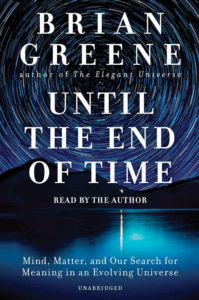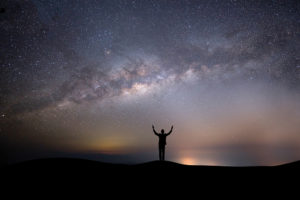Until the End of Time: Mind, Matter, and Our Search for Meaning in an Evolving Universe

BY BRIAN GREENE
KNOPF, 2020
It doesn’t get much more ambitious than this. In Until the End of Time: Mind, Matter, and Our Search for Meaning in an Evolving Universe, Columbia University physicist and mathematician Brian Greene not only attempts to explain the history of the universe from the very beginnings of time through to its probable end, he also tries to extrapolate what it means for us as humans.
Greene sets out his ambitions in the preface, where he says the book will “walk the timeline of the universe, exploring the physical principles that yield orderly structures from stars and galaxies to life and consciousness, within a universe destined for decay. . . [and] examine how self-reflective beings contend with the tension entailed in these realizations.”
Most of the book is spent on the first part of that equation, explaining the science of time and the cosmos and exploring the discoveries we’ve made and are likely to make in the future. It’s astounding, really, to be shown just how much we do know, and how far we’ve come in that knowledge in just the last one hundred years since astronomer Edwin Hubble observed distant galaxies expanding away from each other (an observation that led to the theory of the Big Bang).
Yet Greene’s gift as a writer is his ability to explain the complicated in simple enough terms for the reader to get the gist and move on. For instance, early in the book he outlines the Second Law of Thermodynamics and what is meant by entropy—and if that sounds like a very complicated thing to explain, it is. To put it roughly, since the Big Bang the universe has been expanding, constantly moving towards disorder and coming apart.
 He then explains how, within this overall disorder, there are small pockets of order that arise, and natural laws that bring this about. These small pockets of order are galaxies and star systems, and we’re fortunate enough to live in one. While in the billions of years that lie ahead of us our galaxy will eventually fall back into disorder, for now order prevails, and the natural laws contained within that order have given rise to life, including us humans. Greene explains the origin of elements in four and a half pages. He covers the origin of the solar system in just over two.
He then explains how, within this overall disorder, there are small pockets of order that arise, and natural laws that bring this about. These small pockets of order are galaxies and star systems, and we’re fortunate enough to live in one. While in the billions of years that lie ahead of us our galaxy will eventually fall back into disorder, for now order prevails, and the natural laws contained within that order have given rise to life, including us humans. Greene explains the origin of elements in four and a half pages. He covers the origin of the solar system in just over two.
Things slow down as Greene gets to the most interesting parts for us—our own development. Now in chapters rather than pages he explores the anomaly of our own consciousness, what science has told us about how the mind functions, how language may have arisen, and how we learn. He does so in a writing style that’s both clear and as informal as it could be for such a subject, with some humor. For instance, he detours a bit to explain why we’re different from rocks (not as simple to explain as you might imagine—or hope). But he shows that we’re different, that we’re self-aware in a way no other organisms are, and this leads to the ultimate question. By way of Bertrand Russell’s point that “A dog cannot relate his autobiography, however eloquently he may bark; he cannot tell you that his parents were honest but poor,” Greene asks: How is it that we can?
In posing this question, he explores the nature of belief and why people are drawn to religion as a way of making sense of it all, although he finds faith lacking as an explanation. As to the existence of God (on which he spends no more than a page or two), Greene says,
The closest I come to such literalism is acknowledging that some or other god may exist. I recognize that no one can ever rule out this possibility. As long as a purported god’s influence does not in any way modify the progression of reality that is well described by our mathematical laws, the God is compatible with all we observe. But there is an enormous gulf between mere compatibility and explanatory necessity. We invoke the equations of Einstein and Schrödinger, the evolutionary framework of Darwin and Wallace, the double helix of Watson and Crick, and a long list of other scientific achievements not because they are compatible with our observations, which of course they are, but because they provide a powerful, detailed, and predictive explanatory structure for understating our observations.
Although it’s been about 13.7 billion years since the Big Bang, Greene regularly points out that we now have some scientific certainty that we’re still relatively early in the cosmic unfolding of time. And that eventually all we know will disappear completely—at least that’s our best rational understanding of how the next billion billion billion years will unfold. But while some may find this future bleak (Bertrand Russell for one), for Greene, “the future that science now envisions highlights how our moment of thought, our instant of light, is at once rare, wondrous and precious.”
His final chapter, “The Nobility of Being,” explores our search for meaning, which he’s only hinted at up until this point in the book. He explores our need for order and morality, for experiencing a sense of right and wrong, good and evil, destiny and purpose. These are useful and must be pursued, even knowing it will someday all disappear. And knowing that it will disappear helps us in this, he contends.
“Thinking about life that never ends clarifies the relevance of life that does,” he writes. “[W]e must accept that there is no grand design…. And so, in our quest to fathom the human condition, the only direction to look is inward. That is the noble direction to look.”
That Greene pulls off such grandiose statements at the end of the book is a tribute to the book as a whole. The observations in the last chapter are made possible by the science and understanding explored in the preceding ten. He has put in the work, and made the reader put in the work, to bring us to an educated understanding of where we are, where we came from, and where we’re likely to be going. With this basis we too can arrive at such poignant observations about the future and our place (or lack of place) in it.
